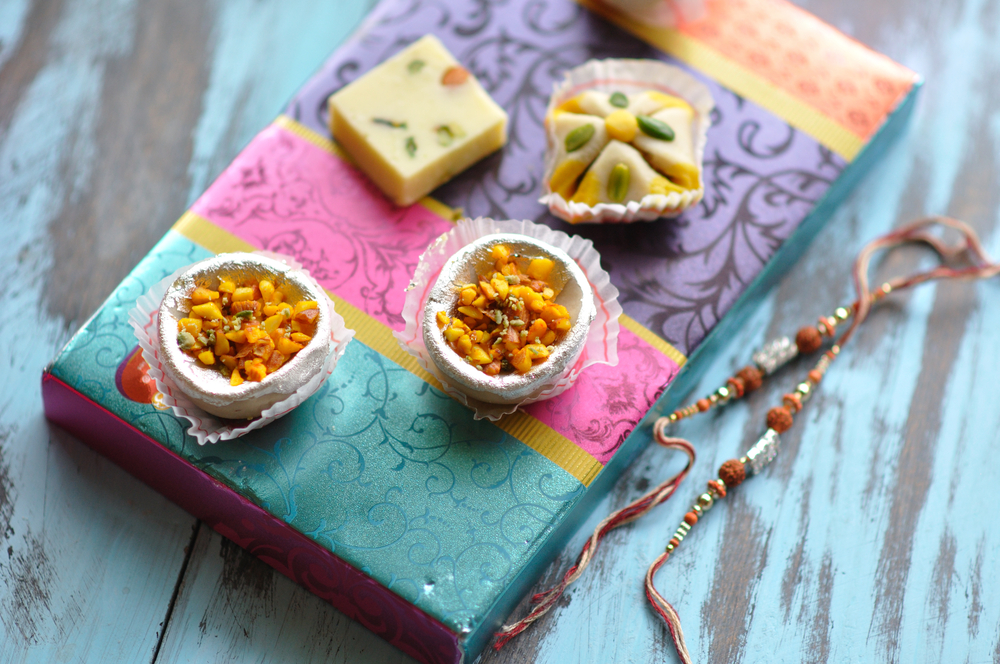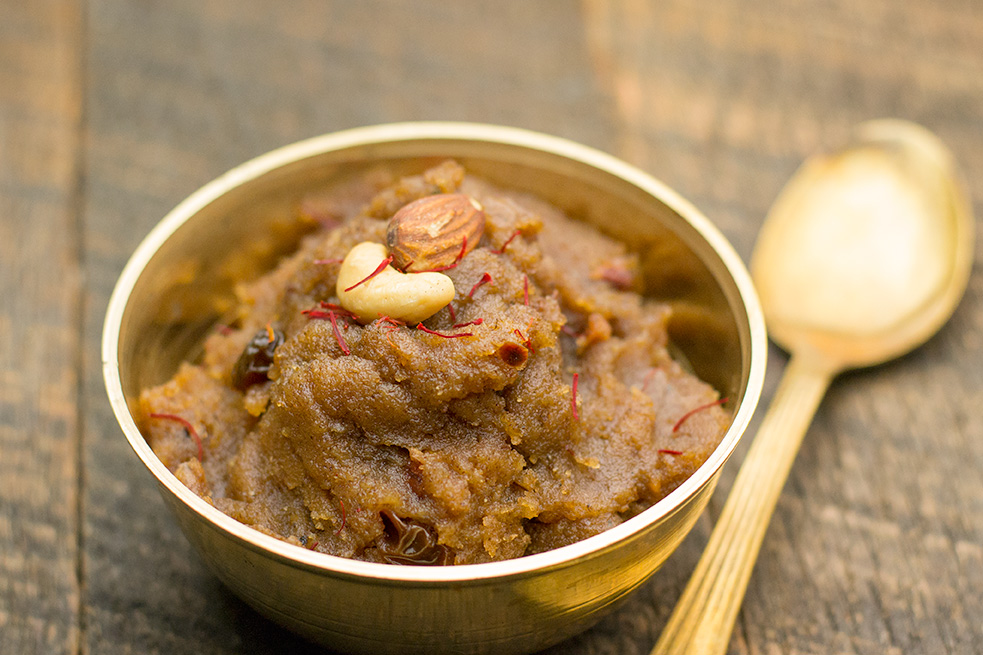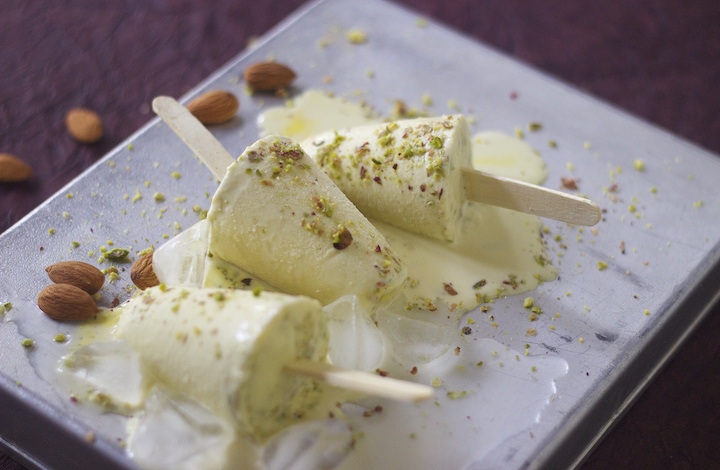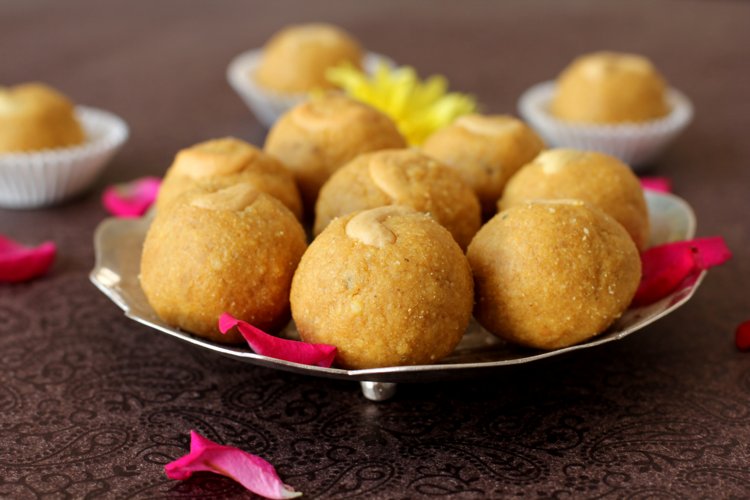
Nothing else represents Diwali in a sweeter and more delightful way than our traditional Indian sweets. When our mothers and grandmothers prepare their own versions of mithai at home, the aroma lifting off brings us to kitchen like bees to honey, reminding us that the festival is knocking on our doors! So, how about this Diwali, we surprise them instead? Try your hand in the kitchen, to shower your family with love and sweets which they won’t be able to stop gushing about.

Image: nomnomaste.com
Sooji Halwa
This simple halwa is a festive staple in most houses and as soon as we get a whiff of the caramelising sooji and cardamom swift through the air, we hit the kitchen to scoop up a bite (or bowlful) straight out of the pan! After all it’s best when eaten freshly prepared.
Caters to: 2 gobblers
Raid your larder of:
1 cup desi ghee, melted
½ cup sooji
⅓ cup sugar
1 ⅓ cups water
Almonds to taste, crushed
Raisins to taste, pre soaked in water for 10 minutes
Cashews to taste, crushed
Cardamom seeds, scraped from 2 cardamom pieces
Cook away:
1. Take a shallow pan and heat ghee in it.
2. Add sooji and keep whisking until the colour turns light brown. Keep the stove at high heat and once the colour starts to change, turn it down to low.
3. In another deep pan, add sugar, water, almonds, raisins, cashews, cardamom seeds and heat until the sugar dissolves.
4. Slowly add the water in the karahi once sooji has turned brown. Make sure it is at low heat to avoid any fire blowouts!
5. Keep whisking constantly to avoid formation of lumps and turn the heat on high.
6. Cook till the halwa reaches a slightly loose but sticky consistency.
It is now ready to be served, piping hot or the cooled down version-both are as delicious, take your pick!
Stevie’s tips:
Be careful of the stove heat, it is essential not to burn the sooji while caramelising. The more you roast it, darker the colour it will achieve in the end.
Keep the halwa softer than the desired consistency, since it will thicken as it cools.

Image: scdn.archanaskitchen.com
Kheer
A cold bowl of rice kheer topped with dry fruits and sprinkled with grated coconut is what follows a traditional Diwali meal in most homes. The subtle cardamom flavour and soothing effect of milk and rice, rejuvenates us from the day’s exhaustion.
Caters to: 4 gobblers
Raid your larder of:
2 kgs milk
100 gm white rice
2 pieces cardamom
1 ½ cup sugar
½ tsp kewra
Almonds to taste
1 sheet varq
Cook away:
1. Take a deep pan and pour milk. Add the seeds from cardamom and boil until the mixture begins to reduce in quantity.
2. Add rice after washing properly with water. Boil until the rice are cooked. Keep stirring at continuous intervals and mash the rice as you stir.
3. Once the rice are mashed and cooked, add sugar and cook until the desired consistency is achieved.
4. Remove from heat and add kewra.
5. Once cooled, transfer to a bowl of choice, mix in crushed almonds and top with varq.
The bowl of delish kheer is now ready to be served.
Stevie’s tip:
You can substitute kewra with rose water according to taste.

Image: feedyourtemptations.com
Kulfi
While the weather is changing it’s nearly not cold enough to keep us away from kulfi! Our most beloved dessert, whether eaten from the street side or made at home always satiates the sugar cravings.
Caters to: 4 gobblers
Raid your larder of:
1 ½ litres milk
A pinch of Saffron
400 gm condensed milk
15 Almonds, crushed (add or lessen to taste)
15 Pistachios, crushed (add or lessen to taste)
¼ cup Khoya, grated
Cook away:
1. In a thick hollow pan, heat milk and as it begins to boil, add saffron. Reduce the heat to low and simmer while stirring continuously until the milk reduces to half in quantity.
2. Mix in the condensed milk, almonds and pistachios. Cook for three to four minutes, stirring continuously.
3. Remove from heat and allow it to cool.
4. Add grated khoya and mix well to ensure no lumps are formed. Once a smooth mixture forms, add it to kulfi moulds and freeze.
5. Once well set, remove from the moulds and serve.
6. Drizzle the kulfi with a spoonful of Rabri and this combination of hot and cold will have everyone in spins!
Stevie’s tip:
A hollow pan allows the heat to be evenly distributed ensuring the milk doesn’t burn from one side.

Image: sailusfood.com
Besan Laddu
What’s Diwali without a bowlful of laddus! One of the most celebrated Indian mithais, laddu has more versions than the seasons of Masterchef India. Winters call for besan laddus and so do festivals, so here is a recipe you can use for this deliciously sinful mithai.
Caters to: 4 gobblers
Raid your larder of:
1 cup desi ghee
½ tsp cardamom powder (optional)
4 cups besan
20 to 25 almonds, crushed
2 cups powdered sugar
Cook away:
1. Take a traditional karahi and heat ghee. Once hot, add cardamom powder and besan to the pan.
2. Roast on low heat till the aroma of caramelised flour fills the air and the mixture becomes slightly brown.
3. Once roasted, mix in powdered sugar and almonds after removing from heat.
4. Allow the mixture to cool and roll into small sized spheres.
Now that the laddus are ready, how about we dig in?

Image: livingfoodz.com
Zarda
While most of the traditional mithais originated here, one of our most cherished dessert roots from Pakistan. Every family has their own version of zarda, or simply sweet rice and we share ours, here with you.
Caters to: 4 gobblers
Raid your larder of:
2 cups basmati rice
½ cup sugar syrup
1 ¼ cups desi ghee
¼ tbsp saffron
½ tbsp rose water
⅓ cup khoya
Almonds to taste
Pistachios to taste
Raisina to taste
Coconut to taste, grated
4 pieces of clove
6 pieces of cardamom
Cook away:
1. Wash the rice properly and soak in water for a while. Half-boil the rice with saffron and four pieces of clove and cardamom each. Strain the rice and allow it to cool a little.
2. Heat ghee in a separate karahi and add 2 pieces of cardamom (intact). Mix in the half-boiled rice and stir lightly.
3. Add the sugar syrup and reduce the heat to low. Add rose water and khoya at this stage and mix in.
4. Cover the pan and keep the heat at low until the rice are fully cooked.
5. Remove from heat and finish off with generous amounts of almonds, pistachio, raisins and coconut.
Zarda is now ready, serve hot. (More so because we can’t wait to stuff it in our mouth!)
Stevie’s tip:
Soak the rice at least for an hour before using, this yields a better texture.
Head over to the kitchen and get started! (Don’t forget to send us some when you are done)
Featured image courtesy: lifestyle.buzzintown.com

